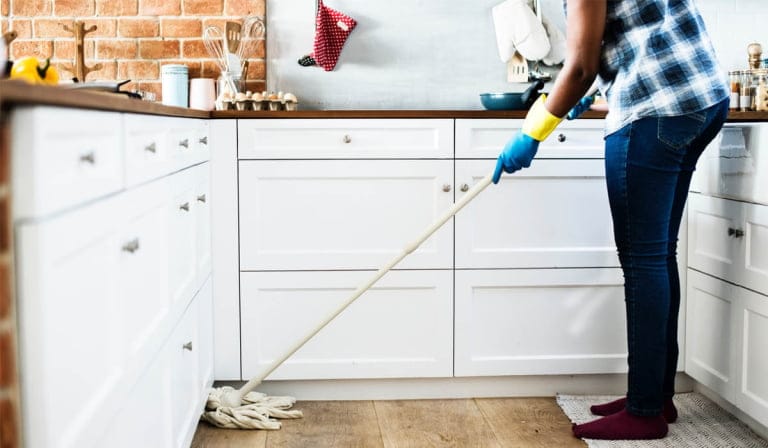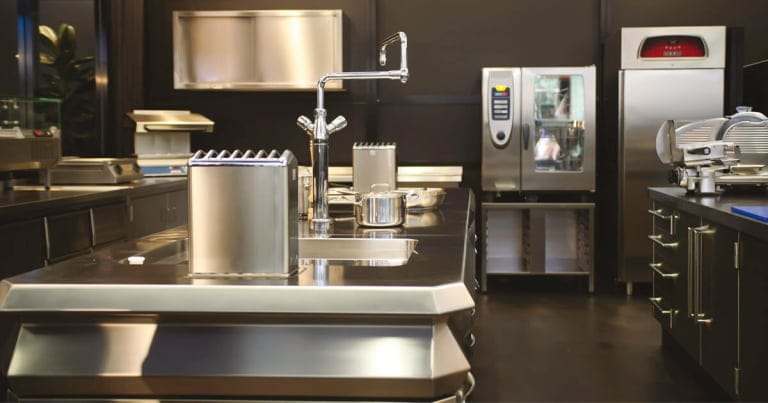Polymerization is a process that allows us to protect the floor from damage, make it shiny and make everyday care of the floor easier. From a chemical point of view, it is the reaction of combining small molecules, called monomers, into large molecules, i.e. polymers.
Why is it worth using a polymer coating on floors?
The polymer coating is intended to protect the surface against scratches. If there is no polymer coating, the top layer of the floor is exposed to abrasion by sand, dust and dirt. The floor then becomes gray and dull. If the surface is protected with a polymer coating, the protective layer will not be subject to abrasion. Meanwhile, the floor will remain intact. In this way, we can extend the life of the floor.
Another reason why it is worth protecting the surface with a polymer layer is the ease of keeping it clean. Thanks to the polymer coating, the floor surface becomes smooth. The coating seals pores and scratches where dirt could penetrate and would be difficult to remove. We are unable to remove the dirt stuck in the scratches. In the case of a smooth polymer floor, the cleaning process is easier. The appearance of the floor is also important. The floor is shiny and looks well-groomed.
Regular care of the floor effectively increases the visual effect of the entire room. It should be taken into account that the floor is one of the elements of every room that we use intensively. Therefore, if we have direct contact with it, we want to tread on a clean surface. Similarly, most people, when entering a room for the first time, have a habit of looking around in order to get used to the new place. One of the first places the eye is focused on is the floor!
What surfaces should you not use a polymer coating on?
Not every type of floor is suitable for protection with polymers. The polymer coating should not be applied to floors with any types of joints, e.g. stoneware, glazed or PVC tiles. Polymers should not be applied to wooden floors due to their high water absorption. This could cause many problems when removing the old polymer coating and neutralizing the floor.
Which surfaces are worth protecting with polymers?
The floor on which polymers are applied should be uniform, e.g. PVC flooring, terrazzo, vinyl, concrete or hot-welded PVC flooring.
Unfortunately, it often happens that polymer coatings are applied by people without professional training. The technology of securing floors with polymers is not a simple process and requires experience, knowledge and professional products. Therefore, before we start polymerizing the floor, we should first prepare properly so that our time, energy and money spent on products are not wasted. Therefore, first of all, you should familiarize yourself with several fundamental principles regarding floor polymerization, and then with its full implementation process, which has been divided into individual stages.
Polymerization process – procedures
To obtain a satisfactory polymerization effect, each stage must be performed carefully, observing all necessary procedures. The floor must be properly prepared and appropriate temperature and humidity conditions must be met. It is not recommended to apply polymers if the substrate temperature is below 10 degrees Celsius and the room temperature is above 30 degrees Celsius. Recommended conditions for applying polymers are 20 degrees Celsius and 60% relative humidity. When applying polymers, avoid drafts, direct sunlight and avoid fans.
Polymers must not be applied immediately after applying the floor covering. The carpet must be “seasoned” – adhesives and other volatile chemicals must evaporate. For safety reasons, the surface on which polymers are applied should be excluded from use. Failure to follow these rules may result in the protective coating quickly wearing off, turning gray, or causing white dust to form.
Applying a polymer coating – stages
Proper application of a polymer coating to the floor can be divided into three main stages. The first one is proper surface preparation, the second one concerns surface neutralization. The last stage is the application of polymers. A professional approach to each of the above-mentioned stages guarantees appropriate protection and, therefore, a satisfactory effect.
Surface preparation
The first stage of the whole process is the preparation of the floor. Remove loose dirt and dust, then clean the floor and remove old polymer layers. A very good product for this purpose is Clinex Dispersion STRIPPER . It is a preparation with very high cleaning power. When removing polymer coatings, do not dilute the product and leave it on the surface for about 10-15 minutes, not allowing it to dry. After this time, clean the surface with a scrubber to completely remove dirt and polymers. The reaction of the floor after using Clinex Dispersion Stripper is alkaline.
Surface neutralization
We cannot apply a polymer layer to such a surface because it could cause problems with polymer adhesion and therefore the next important step is surface neutralization. It is best to neutralize the floor by washing it with plenty of clean water. We repeat the process until we obtain a neutral reaction of the floor. Then we wait until the floor dries thoroughly. Humidity on the surface may cause the resulting protective filter to be insufficiently durable.
Application of polymers
When the floor is dry (also free from moisture), we can start applying the polymers. We can choose from acrylic, styrene or olefin polymer coatings and their combinations with various additives, e.g. waxes or polyurethanes. Acrylic polymers are the most popular. One of the products based on these polymers is Clinex Dispersion SOFT . It is a preparation with polishing properties and creates a durable coating resistant to damage. Perfect for heavy traffic areas. It has anti-slip properties. Contains 20% solids.
A very good solution is to apply polymers in medical facilities. These are high-risk places and the cleaning process is specific. Hospital floors are exposed to contact with ethyl alcohol, which damages polymer coatings. The polyurethane polymer is resistant to alcohol. Clinex offers us the Clinex Dispersion HARD product based on acrylic and polyurethane polymers. It is a preparation with strong polishing properties. It creates a very durable, high-gloss coating, resistant to damage and alcohol. The urethane-reinforced coating provides long-lasting and very intense shine. The product contains as much as 25% solids. This is undoubtedly one of the most outstanding floor polymerization products among all currently available on the market. Moreover, it guarantees perfect value for money.
Daily cleaning
To maximize the life of a polymer floor, it must be properly cared for. The most important activities are daily removal of loose dirt by sweeping or vacuuming and washing with an appropriate preparation that will not damage the polymer surface. This will help us avoid the polymer becoming matte, yellowing or abrasive. The product for cleaning floors covered with polymers should have a neutral pH. A good solution is to use Clinex Dispersion CARE . It is a low-foaming product for everyday cleaning of floors. Removes dirt quickly and effectively. It contains polymers that will help us keep the floor in good condition for as long as possible and postpone the process of further polymerization until a later time.
Applying polymer layers is a very good solution in terms of aesthetics and hygiene. Recently, we have been observing increasing customer interest in polymer preparations. Unfortunately, users of these preparations learn very slowly how to properly use them, hence the need to provide appropriate knowledge in the field of applying and caring for polymers.
Conclusions
- The polymerization process protects the floor against damage.
- Polymerization makes the floor neat and shiny.
- The polymer coating protects the floor against scratches. It creates a protective layer on it, which means that any dirt rubs it off and not the floor.
- The polymer coating smoothes the floor surface.
- You should take care of the floor regularly because it extends its life and ensures an aesthetic appearance.
- Not every surface can be treated with a polymer coating.
- It is recommended to avoid polymerization on surfaces with joints, e.g. stoneware, glazed or PVC tiles, and on wooden floors.
- Polymers can be applied to uniform surfaces.
- The most popular uniform surfaces include PVC flooring, terrazzo, vinyl, concrete and hot-welded PVC hospital floors.
- Correct application of polymers to the floor requires appropriate preparation.
- Floor polymerization should take place at 20 degrees Celsius and 60% relative humidity.
- The new carpet should not be polymerized.
- The correct course of polymerization consists of three stages.
- First, the surface must be properly prepared. Remove any dirt from it. Clinex Dispersion STRIPPER can be used for this purpose.
- Then the surface should be neutralized.
- The final stage is the application of polymers
- We can choose the type of coating, e.g. acrylic, styrene or olefin, as well as their combinations with various additives such as waxes, etc.
- For acrylic polymers, Clinex Dispersion SOFT can be used.
- If we need a product based on acrylic and polyurethane polymers, Clinex Dispersion HARD will be the solution.
- However, to care for floors covered with polymers, it is worth using Clinex Dispersion CARE.






